Neighbors and Volunteers
Air Date: Week of April 6, 2007
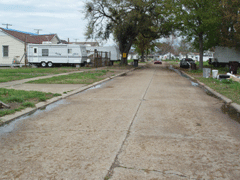
A year and a half later, people are still living in FEMA trailers, not their homes. Chalmette, St Bernard Parish, La. (Photo: Ingrid Lobet)
Many New Orleans residents are frustrated by a lack of state and federal help for rebuilding. But that's not stopping neighbors from organizing on their own. They're getting significant help from thousands of volunteers, brought in by faith groups and other non-profits. Living on Earth’s Ingrid Lobet reports that much of the progress made in post-Katrina New Orleans is thanks to this collaboration among neighbors, non-profits and volunteers.
Transcript
CURWOOD: It’s Living on Earth. I’m Steve Curwood. Hurricane forecasters are predicting that 2007 will once again be a big year for storms. They’re projecting nine hurricanes, including five of at least category three strength, akin to the blockbusters of 2004 and 2005. Of course there were similar predictions for last year, which did not materialize, likely due to the dampening effect on storms of the El Nino weather system.
The prospect that another major hurricane could come ashore in the US this year can hardly bring comfort to the people in the Gulf Coast region, who were savaged by Hurricanes Katrina and Rita in 2005. Today, 18 months after the storms, many New Orleaneans still live in 240 square feet of space—that is, in FEMA trailers, in their own driveways, next to bare foundations or the gutted frames of their former homes.
And many city residents are frustrated. They’re fed up with struggling to get loans and grants to rebuild their houses. But neighbors are still helping neighbors. And they’re being helped in turn by a remarkable flow of young volunteers still streaming in from around the country. Living On Earth’s Ingrid Lobet reports from New Orleans.
LOBET: This neighborhood in New Orleans East is a stretch of tidy post-war homes with front yards mostly still bare after their saltwater soaking by Lake Pontchatrain, a couple of blocks up the road. The white rear-ends of a few FEMA trailers butt out into driveways.
RUSSELL: But a few months ago there were more trailers than this. There were really more trailers than this. The majority of our trailers are leaving. That’s a good sign.

A year and a half later, people are still living in FEMA trailers, not their homes. (Chalmette, St Bernard Parish, La.) (Photo: Ingrid Lobet)
LOBET: Tangy Russell keeps vigil over her neighborhood by day. At night, when she’s at work at the Post Office, her neighbors keep watch. Determined to stay connected after the storm, somehow, together, they’ve created the certainty for each other to return.
RUSSELL: One of them found out that most our neighbors were coming back. So one told the other and then word spreaded out that the majority was coming back. That gave us the green light to go ahead and start redoing our houses.
Heyyyyyyy!! She’s one of our workers with Energy, but she lives down the street too.
LOBET: These neighbors mow the lawns of the few houses still vacant.
RUSSELL: Basically if I need help with roofing or something I’ll call one of the guys and he’ll come. So we pretty much help each other out. Because have a neighbor down there, he’s in Iraq right now. We keep in touch with him. He calls us once a month and let’s us know he’s okay. So once we get everybody back, we’re going to have a seafood broil in the neighborhood.
LOBET: And today is another advance toward that date, because the house across from Russell’s, vacant for so long, is finally getting its guts removed.
[SMASHING SOUND]
LOBET: A group of students from the College of Wooster in Ohio wear white Tyvek suits, smash through drywall and shovel it out onto the curb. On top of a little pile the students have set aside is a card that says “Mom you are valued, you are needed, you are loved.”
Inside, the walls were once light blue. Now, a fierce black mold populates the walls up to a perfect line at about three feet: the line where water sat. The splotchy mass is nearly a quarter-inch thick in some places.
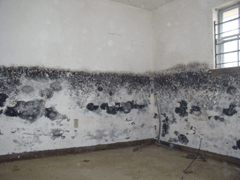
Mold reveals the water line in New Orleans East. (Photo: Ingrid Lobet)
MALE STUDENT VOLUNTEER: Whistle. Hey where the keys at to the blue van?
LOBET: A few hours later, the house is gutted and some students move on to the next house.
These volunteers and thousands of others are a feature of today’s New Orleans. They come from all over the country, in wave after wave, organized by student associations, church youth groups, young activists.
[SOUND OF A YOUNG CROWD]
On any given morning, you can find a newly-arrived group getting orientation, as here at Louisiana United Methodist Storm Recovery.
WOMAN: We have one of New Orleans’ finest (clapping). This is Sergeant Favoloro. He’s going to talk to you about safety while you’re here this week.
FAVOLORO: I’m John Favoloro I’m assigned to the 6th district. This area round here, I’m not going to lie to you, is one of the hottest areas we have. Just around the corner the other day we had a drive-by shootin’. All our shootings up here are dope dealers. They shootin’ each other. We had three of ‘em Saturday. But while you’re up here, be careful. You ladies like to shop they got all kind of blue jeans places, used blue jeans and everything else. But around here don’t go roamin’ at night. When you all do these houses, pay attention what you doing, we been having a lot of trouble with spiders, a couple of policemen got bit. Make sure it’s well-lit. And that’s all I gotta tell you.
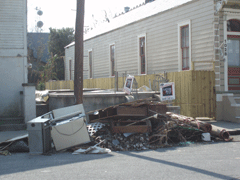
An owner tries to sell a lot with only a bare foundation. The remains of the house lie in front. (Photo: Ingrid Lobet)
MALE VOLUNTEER: Sir?
FAVOLORO: Uh huh?
MALE VOLUNTEER: What kind of spiders was it?
FAVOLORO: The brown recluse.
[AUDIENCE GASPS]
FAVOLORO: But y’all be careful out there. And thank y’all. We really do appreciate it. Because if it wasn’t for y’all, we would be in deep trouble. And thank y’all from the people of New Orleans.
[CLAPPING]
LOBET: The owners of the houses where the volunteers will work may be elderly, disabled, for some reason unable to do the tear-out on their homes. Recovery center staffer Shawn Darnell reminds the volunteers to be compassionate about what that person may have been through.
DARNALL: You may look at something and say this is not worth saving. Why does she want to keep this?
LOBET: Darnall tells them to collect any papers that could be used for identity theft. The volunteers’ work will enable the crucial next step, treating the framing for mold.
DARNALL: Your goal when you walk out of that house is to have nothing but the exterior walls and the studs showing.
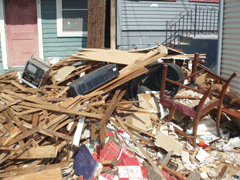
A common sight in New Orleans a year and a half after Hurricane Katrina. (Photo: Ingrid Lobet)
[SOUND OF METAL TOOLS CLANKING]
VOLUNTEER COORDINATOR: You got kneepads, crowbars, small sledges.
LOBET: And with that, volunteers collect hand tools and fan out across the city to their assignments. Shawn Darnall sits down for a minute to breathe, between back-to-back orientations.
DARNALL: I think our Baton Rouge headquarters told us we would see over 3000 volunteers for the month of March. We have no more housing for the month of March.
LOBET: Since the storms, she estimates her group has brought in 25,000 people. That’s just United Methodist efforts. It doesn’t count Habitat for Humanity or Catholic Charities or other large non-profits.
DARNALL: I have been surprised by the response 18 months later. Because all the experts told us after the first year it is going to decrease drastically. And we have more volunteers here than we’ve ever had before, by double. We know that this summer, we have another very big influx of volunteers. It’s amazing.
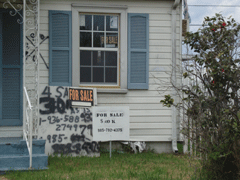
An owner tries to sell a home in Chalmette, St. Bernard Parish, La. (Photo: Ingrid Lobet)
LOBET: People like Darnall who direct these scores of volunteers are disaster victims themselves. They haul themselves out of bed in the morning, and face personal restoration while they try to raise up their city.
DARNALL: My house was okay but Katrina has torn my family apart. My husband is working in California and has been there for a year now and we don’t have an end in sight.
LOBET: Only half as many people live in the city as before. Half a population means half an economy. Darnall’s husband works for Southwest Airlines, which offered to keep its employees on if they would relocate somewhere people were still going. The family’s best compromise on income, stability and school left their eight-year-old son Colton living away from his Dad.
DARNALL: And there is despair still and the devastation. Certain areas of the city you look around and it is a ghost town. The frustration with even now, 18 months later, going to the grocery store and there not being any eggs, because they might be delivered, but they don’t have the staff to get them out. Just living here on a day-to- day basis can be nerve-wracking.
LOBET: She worries about her son.
DARNALL: That is my fear as a mother, that he grows up and eight to ten years from now and he says my life was normal until Katrina.
[SOUND OF CHILDREN]
LOBET: After a day of often physical work, the volunteers return to wherever they’re camped, in this case Carrollton United Methodist Church. The stately building is showing some wear; it’s been given over to need.

Volunteers from all over the country share a church floor for the night. (Photo: Ingrid Lobet)
MARSHALL: The lady’s house we worked on, she hasn’t been seen since the storm and they just put a note up on her house.
MISSEN: And she’s an old lady and she’s in a wheel chair and they expect her to just come clean all this up. I was disgusted. I was just like, how can you do this to your own people?
MARSHALL: They don’t even have power yet.
STAVELY: These are people who had to work for what they have and they were proud of what they had.
LOBET: The loss leaves a powerful impression on Mike and Eve.
MISSEN: Like a lot of it is just clear and like overgrown, but you can still see the bare foundations and you just realize how many houses were ripped up and destroyed.
STAVELY: They’ll never forget the memories. Going on a tour today, she can point out, that open lot was so-and-so’s house and she knew who lived there.
MISSEN: Like there’s just one spot where all the oak trees had like overgrown into a canopy, and she said the whole street had been like that. At the end there were just four trees like that. It was just sad to see how much has been destroyed.
LOBET: Everywhere they go, Anna Kann says, they encounter gratitude.
KANN: Just random people in the street will tell us they are happy we are here and it makes me feel really good but I just want them to get their houses back.
LOBET: Several kids say they felt misled by media coverage. “How could I not know the number of people who died in these storms?” Abi Marshall asked.
MARSHALL: I feel like you shouldn’t have to come here to know the damage that’s been done and you shouldn’t have to come here to like see what’s happened. There is so much that went on that I feel like I would never have known if I hadn’t come here, it’s been a huge eye-opener, I know now I can’t take things at face value.
LOBET: Older students also said what they’d seen on TV did not prepare them for reality.
FITZGERALD: I’m Aaron Fitzgerald and I’m from Rhodes College in Memphis, Tennessee. When I came down here and I saw cars still flipped over, roofs just off of persons’ house. And today we gutted someone’s house and her floor - this was in the lower Ninth Ward - her floor was just completely still damp and I had to bring her inside and say “Do you want me to tear up your whole floor or do you want us to just leave the frame?” My friend Jamie fell through twice, I fell through once. It was awful.
LOBET: The trip, though, he says is worthwhile.
FITZGERALD: I recommend anyone to come down here because if you do, your life will be changed. I feel changed.
LOBET: Fitzgerald recounts that one of his group leaders marveled at the numbers of volunteers. But he was struck by something different.
FITZGERALD: I’m thinking in my head “We’re supposed to be a first world country and we still have others living in 3rd world poverty in our own country, in a city that is a major city.”
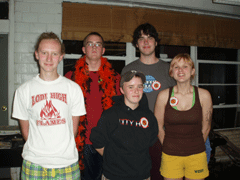
Iowa City high school students tore out overgrown brush and rebuilt a ballfield in New Orleans. (Photo: Ingrid Lobet)
LOBET: Still older students, law students, have formed their own Student Hurricane Network. Since the storms, the Network has brought down 2,700 law students to the Gulf Coast and organized others long distance. Lauren Bartlett is in her third year at American University.
BARTLETT: First of all I think there is a new generation of law students which are committed to public interest work, maybe even some who came to law school since the storms of 2005 for the particular purpose of being involved.
LOBET: Morgan Williams is co-founder of the Network and a third year student at Tulane. He says even though they’re students, not attorneys, and even though Louisiana Law is unique, the students can be extremely helpful.
WILLIAMS: Basically, in communities where homes have been handed down for generations and generations, folks at the time of the storm, might not have had the actual piece of paper that says they were the owner of that home. And when the home gets destroyed and everyone gets displaced, the state says we need that piece of paper. So because the federal funding that’s being administered through the state through the Road Home program is linked to having that piece of paper, they are being locked out from being able to receive those funds and being able to begin the process of rebuilding.
LOBET: Pro bono attorneys who can help people with these affidavits are so overwhelmed they can’t take more applications. Enter the law students. The teams are also carrying out a major survey of people who are still, this long after the storm, living in FEMA trailers.
BARTLETT: The residents living in trailers are the most forgotten, the most marginalized. There are a lot of needs, but we have to find out what those are before we can move.
WILLIAMS: It’s something that’s bringing the law students face to face with the realities of the rebuilding process, and the frustration and the anger people and the sources of those frustrations and anger that folks down here are really facing in their efforts to rebuild.
LOBET: Bartlett says she’s one of the law students whose life direction has been changed.
BARTLETT: When the storm hit, you know some things really touch you; in a way that you can’t use words to describe. And when the storm hit, I felt very connected and felt it really personal about it all. I started fundraising at my law school and having conferences, getting articles published, and came down and have been here every second of every day I could possibly spare since. I’m going to be moving down here in August. I want to live here.
[SOUND OF A MEETING]
LOBET: Every Tuesday night, people in the Holy Cross neighborhood in the Ninth Ward meet. They’ve met for years, but now their work is all strategy, related to rebuilding and protecting their historically rich and devastated neighborhood. They sort through bureaucratic and day-to-day hurdles.
WOMAN: And one guy said he had a building permit number but when he tried to get a building permit, they told him he had no building permit.
WOMAN2:I haven’t had a refrigerator since Thanksgiving
WOMAN3: Mine just broke down this weekend and everything in it spoiled.
LOBET: But that doesn’t mean there’s no progress. Residents make plans for opening a new store and donation center for green building materials. They applaud a group of first year medical students from Dartmouth who’ve stopped in. They’re helping rebuild a neighborhood clinic. And there’s a happy announcement, more people are coming back; the Post Office is delivering to 800 houses in the neighborhood, up from 200 a month and a half ago.
At the break, 77-year old Jeanne Lee stops to discuss how things are going with her property.
LEE: I was in the area on Monday getting my house gutted out. The houses are really coming back.
LOBET: Who was gutting your house out?
LEE: It was some volunteers from the University of New Hampshire. Very lovely young people. They worked very hard. They started about nine and worked until five in the evening—and the house was completely gutted.
LOBET: But when it comes to taking the next step, rebuilding, Lee, like so many people here, has been waiting for a letter that says she’ll get some State recovery help. It hasn’t arrived.
LEE: So now I have to go and make a loan if I want to repair the property. And at my advanced age I don’t know how that is going to work –that has me bothered.
LOBET: But Jeanne Lee made sure I knew, before the meeting resumed, that she plans to meet the challenges.
LEE: I’m 77 and I have not begun to fight. I’m going to fight to keep my house.
LOBET: The Holy Cross meeting adjourns; it’s late. Tonight, under roofs across the city, young volunteers will set out air mattresses, assimilate what they’ve seen, wash dishes together.
[SOUND OF DISHES]
VOLUNTEERS: (singing) If that ain’t love then I don’t know what love is. If I had to choose her or the sun…
LOBET: And in a too-quiet neighborhood elsewhere in the city, an ice cream man drives a distance before there’s someone to spend a dollar.
[SOUND OF ICE CREAM TRUCK]
LOBET: For Living On Earth, I’m Ingrid Lobet in New Orleans.
[MUSIC: The Dirty Dozen Brass Band “Amazing Grace” from ‘Funeral For A Friend’ (Rope-A-Dope Records - 2004)]
Links
A special edition in The Times-Picayune: "Last Chance"
Greater New Orleans Community Data Center
Center for Bioenvironmental Research at Tulane and Xavier Universities
Louisiana United Methodist Disaster Recovery Ministry
Living on Earth wants to hear from you!
Living on Earth
62 Calef Highway, Suite 212
Lee, NH 03861
Telephone: 617-287-4121
E-mail: comments@loe.org
Newsletter [Click here]
Donate to Living on Earth!
Living on Earth is an independent media program and relies entirely on contributions from listeners and institutions supporting public service. Please donate now to preserve an independent environmental voice.
NewsletterLiving on Earth offers a weekly delivery of the show's rundown to your mailbox. Sign up for our newsletter today!
 Sailors For The Sea: Be the change you want to sea.
Sailors For The Sea: Be the change you want to sea.
 The Grantham Foundation for the Protection of the Environment: Committed to protecting and improving the health of the global environment.
The Grantham Foundation for the Protection of the Environment: Committed to protecting and improving the health of the global environment.
 Contribute to Living on Earth and receive, as our gift to you, an archival print of one of Mark Seth Lender's extraordinary wildlife photographs. Follow the link to see Mark's current collection of photographs.
Contribute to Living on Earth and receive, as our gift to you, an archival print of one of Mark Seth Lender's extraordinary wildlife photographs. Follow the link to see Mark's current collection of photographs.
 Buy a signed copy of Mark Seth Lender's book Smeagull the Seagull & support Living on Earth
Buy a signed copy of Mark Seth Lender's book Smeagull the Seagull & support Living on Earth

